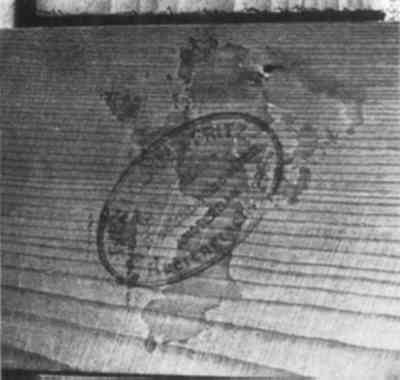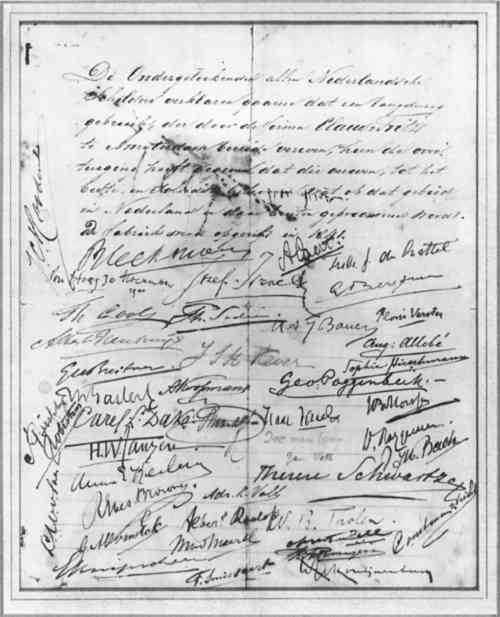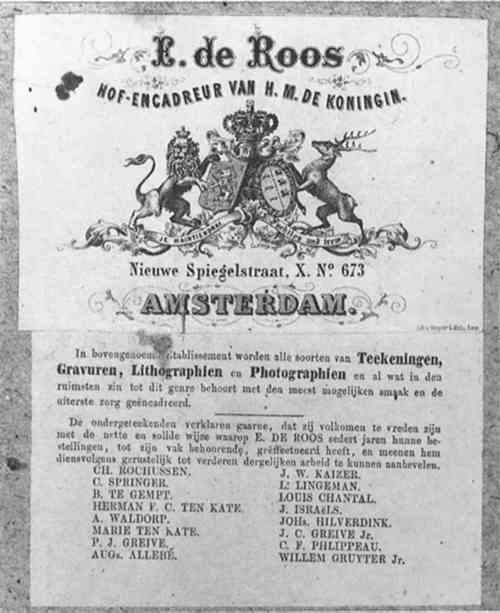WITH PAINT FROM CLAUS & FRITZ: A STUDY OF AN AMSTERDAM PAINTING MATERIALS FIRM (1841–1931)MICHEL LAAR, & AVIVA BURNSTOCK
1 INTRODUCTIONOn the backs of canvases and panels, as well as on frames and stretchers, helpful information can sometimes be found regarding the provenance, dating, and attribution of a painting. That valuable evidence such as labels, numbers, seals, and stamps should be preserved goes without saying. In 1993 two labels of the firm of Claus & Fritz, suppliers of artists' materials, were documented on the stretchers of two paintings by Gerrit Willem Dijsselhof (1866–1924) (fig. 1). Later that year, in the Van Beek artists' supplies shop on Stadhouderskade in Amsterdam, which is now nearly 100 years old, another piece of
The signatories were J. C. Roodenburg, A. Coert, W.C.C. Bleckmann, Jozef Israels, G. Bergsma, F. J. van Rossum du Chattel, T. Cool, P. Sad�e, M.A.J. Bauer, Floris Verster, Albert Neuhuijs, J.S.H. Kever, A. Alleb�, Sophie Hirschmann, G. H. Breitner, N. Bastert, A. Koopmans, G. Poggenbeek, S. Bisschop-Robertson, Carel L. Dake, P. N. van Agt, Isaac Israels, W. B. van Horssen, H. W. Jansen, J. van Looy, Jan Veth, D. Roggeveen, J. M. Bach, C. W. van Laer, Anna E. Kerling, Th�r�se Schwartze, R. Ives Browne, A. L. Valk, G. H. van Eck, Albert Roelofs, W. B. Tholen, M. van der Maarel, H. van der Poll, Constance van Tricht, E. Knipscheer, F. Smissaert, B. Bongers, and W. A. van Konijnenburg. Most of the signatories were members of Arti et Amicitiae, an artists' society in Amsterdam, or of Pulchri Studio, an artists' society in The Hague. Most were born in the 1850s. By far the oldest among them was Jozef Israels, who was probably the first to sign, since the date appears to be in the same hand as his signature. The other signatures were added at different times, and the artists need not be regarded as a single group at any one time or place. The initiative was obviously a commercial one on the firm's part, but the idea was not unique; witness the presence on a mounting board in an empty frame in the Rijksmuseum of a printed label of the frame maker E. de Roos of Amsterdam, which dates from before 1870 and is signed by 16 artists (fig. 3). Here the commercial intentions are again very clear. The idea of such a recommendation by artists may have come from England, where in 1869 a similar recommendation, in this instance for “Improved Studio Easels,” was printed in an advertisement for Winsor and Newton (Field 1869, 38–39)(fig. 4). It is not inconceivable that the signatories also gained some sort of financial advantage, a discount on future orders, for example.
Since the signatories of the Claus & Fritz testimonial must all have been among the firm's customers, we now know the names of 43 painters who certainly must have acquired their materials from the Amsterdam concern. The fact that a number of them lived in The Hague, and later became known as The Hague School of Painters, testifies to the firm's importance. Its reputation is also suggested by a letter of 1903 to the critic Albert Plasschaert from Willem Bastiaan Tholen (1860–1931), who, in response to a request for biographical details, summed up his life as follows: “Born in Amsterdam in 1860 and not dead yet, paints with paint from Claus & Fritz” (De Jong 1994, 159). |



